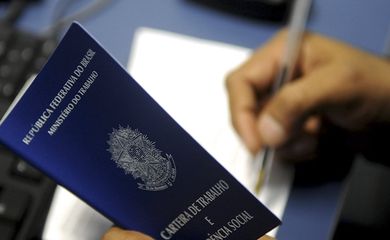IBGE survey shows a weakening of the labor market in 2020

The covid-19 pandemic, which began in 2020, had a negative impact on the Brazilian economy and, especially, on the labor market, worsening the results that were already insufficient to improve the population's living conditions. This is shown in the Synthesis of Social Indicators (SIS): an analysis of the living conditions of the Brazilian population, released today (3) by the Brazilian Institute of Geography and Statistics (IBGE), in the chapter on economic structure and the labor market.

The evaluation of the evolution of the Gross Domestic Product (GDP) and the dynamics of household consumption, both per capita , that is, per individual, reveals that the positive results observed until half of the last decade, with accumulated growth rates between 2010 and 2014 of 12.9% and 16.6%, gave way, in the final six years of the series, to drops of 10.8% and 10.6%, respectively. In 2020, the retractions were 4.8% of GDP and 6.2% of household consumption per capita .
The pandemic caused a strong retraction in the job market. Unemployment and underutilization rates, which were already high after the 2015-2016 crisis, increased further in 2020, reaching, respectively, 13.8% and 28.3%. The occupancy level was, for the first time, at 51%, the lowest in the series. According to the IBGE, among young people aged 14 and 29, this indicator dropped from 49.4% in 2019 to 42.8% in 2020. In 2012, it was 53.7%. Between 2019 and 2020, the informality rate of the employed population in the country dropped from 41.1% to 38.8%. Among blacks and browns, this rate in 2020 was 44.7%, against 31.8% of the employed white population. In addition, blacks and browns represented 53.5% of the employed population and 64.5% of the underemployed due to insufficient hours.
Employees with a formal contract, which include employees with a formal contract, military personnel and statutory civil servants, had a relative increase in 2020 of 49.6%, while employees without a formal contract fell from 20.2% in 2019 to 18.1%, last year. Self-employed workers remained stable, with a rate of 25.4%.
The covid-19 crisis particularly affected jobs in the service activity, especially in accommodation and food, with a drop of 21.9%; domestic services (-19.6%); and others (-13.7%).
inequalities
The IBGE survey confirms the maintenance of historical inequalities in the national labor market. While the total employed population (PO) is predominantly black or brown (46.3 million), surpassing the white PO (39.5 million) by 17%, there is a clear difference in the distribution, as in lower-paid activities and greater informality predominate black or brown color or race workers. Examples, in 2020, were domestic services (+91%), construction (+83%) and agriculture (+58%). On average, the average real income of the employed white population (R$ 3,056) was 73.3% higher than that of the black or brown population (R$ 1,764) in 2020.
The income of men (R$2,608) was 28.1% higher than that of women (R$2,037). With the pandemic, 18.6% of workers were away from work, with a predominance of women (23.5%) compared to men (15%).
In terms of average earnings per hour of work, inequality between whites and blacks or browns reached +69.5% last year and remained between races, regardless of education level. With complete higher education, the difference between hourly earnings reached 44.2% more for whites.
Last year, men predominated in the employed population, with 58.3%, against 41.7% of women. Among the population underemployed due to insufficient hours, women were the majority in 2020 (52.4%), the same occurring among people of black or mixed color or race (64.5%). Workers with complete secondary education or incomplete higher education were the majority (36.9%), followed by people with no education or with incomplete primary education (31.5%).
The analysis of remote work due to the pandemic shows that absenteeism was greater between May and August of last year, with a slight decrease until November. Women were the majority among home office workers, the same occurring among people of color or white race and among those with complete higher education or postgraduate studies, which was six times greater than workers with complete secondary education or higher. incomplete. IBGE also identified that there were no major differences by age groups.
social benefits
According to the survey, the weight of social benefits on household income, because of emergency aid granted by the government, rose from 1.7% in 2019 to 5.9% in 2020, with stronger impacts in the regions North (increase from 4.1% to 11.6%) and Northeast (from 4.4% to 12.8%), where there are higher levels of inequality and poverty. Including benefits from social programs, per capita household income dropped 4.3% in the country between 2019 and 2020. In the simulation without social benefits, IBGE found a drop of 8.4% in household income per individual.
Considering the insufficient income of families to provide for their well-being, excluding other factors that characterize poverty, such as access to adequate housing, quality basic education, social protection, among other important factors, the survey found that, in 2020, the incidence of extreme poverty could range from 3.5% to 10.5% of the population and poverty between 6.5% and 29.1% of the population, depending on the line adopted.
The number of Brazilians in extreme poverty fell from 6.8% in 2019 to 5.7% in 2020, but increased compared to 2014 (4.7%), remaining stable compared to the beginning of the series, in 2012 (6%). Poverty fell to 24.1% last year, after reaching 25.9% in 2019, but it rose compared to 2012 (27.3%) and remained stable compared to 2014 (23.8%) . The IBGE highlighted, however, that without the benefits of social programs, the proportion of people in extreme poverty would have increased from 9.7% to 12.9%, and the rate of people in poverty would have risen from 28.2% to 32, 1%.
The proportion of people with a per capita household income below US$ 1.90, the line recommended by the World Bank to measure poverty in the poorest countries, surpassed 11.3% in four units of the Federation: Amazonas, Maranhão, Pernambuco and Sergipe. In seven units, this percentage was above 8.2% (Acre, Roraima, Amapá, Piauí, Ceará, Paraíba and Bahia). For Brazil, a country considered to have an upper middle income, the recommended line is US$ 5.50/day, recalled the IBGE.
The average household income per capita in 2020 was R$1,349, down 4.3% compared to 2019 (R$1,410). If there were no social programs last year, this income would have been 6% lower (R$ 1,269). The tenth of the population with the lowest income would have lost 75% of their income without these social programs, indicated the IBGE researchers.
Poverty was highest among children, with 38.6% for those aged 0 to 14 years, among people with per capita household income below US$ 5.50/day, in 2020. In the combined analysis of sex and color or race, black and brown women had the highest incidences of poverty (31.9%) and extreme poverty (7.5%), as shown in the Summary of Social Indicators.
Text translated using artificial intelligence.



